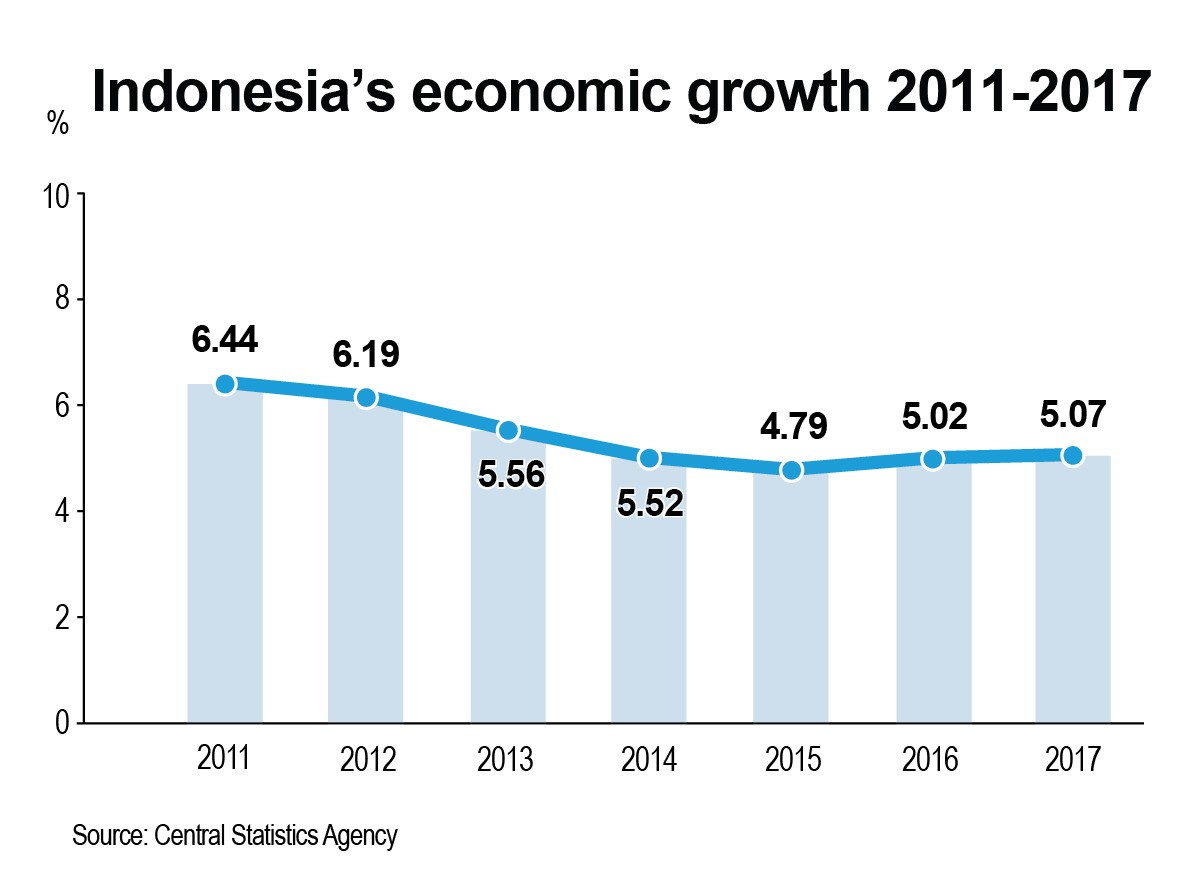Popular Reads
Top Results
Can't find what you're looking for?
View all search resultsPopular Reads
Top Results
Can't find what you're looking for?
View all search resultsGDP growth of 5.16 percent or 5.17 percent – does it really matter?
While even slight deviation in GDP growth can have a real impact on the economy, the degree of this effect differs from one year to another.
Change text size
Gift Premium Articles
to Anyone
R
obert Z. Lawrence, a professor of international trade and investment at Harvard University, once joked during an international seminar in Nusa Dua, Bali that being an economist tasked with forecasting Indonesia’s economic growth was probably “the easiest job in the world”.
Lawrence’s joke was to highlight Indonesia’s consistent growth of around 5 percent over the last couple of years, which he said was stable compared to other countries.
Statistics Indonesia (BPS) revealed that the last time Indonesia had recorded gross domestic product (GDP) growth below 5 percent was in 2015, when the economy expanded 4.79 percent year-on-year (yoy). In 2016 and 2017, GDP growth was recorded at 5.02 percent and 5.07 percent, respectively.
The 2014 data, however, marked but a blip in the long-run trend, as Indonesia posted on average 5.3 percent GDP growth between 2000 and 2017, according to data compiled by the National Development Planning Board (Bappenas).
As if to prove Lawrence’s point, the country’s economists and government officials often come up with GDP growth projections that only differ in decimal fractions from one another.
Finance Minister Sri Mulyani Indrawati, for example, expected the country’s economy to expand by 5.15 percent in 2018, which is slightly lower than 5.17 percent projected by Coordinating Economic Minister Darmin Nasution. The ministers’ projections were well below the 5.4 percent target stipulated in the 2018 state budget. The realized figure in 2018 was 5.17 percent as correctly predicted by Darmin.
Maybank Indonesia economist Myrdal Gunarto projected 2018 GDP growth to fall between the two minister’s projection, at 5.16 percent.
But what is the significance between those decimal variations? The Jakarta Post asked several economists and a government official about the reason for it and its implications for macroeconomic indicators.
Why do GDP growth projections differ only slightly in Indonesia?
According to Pungky Sumadi, Bappenas deputy of population and manpower affairs, there is nothing extraordinary about people having different estimates, as they have their own subjective ways of looking at a set of data.
“[Different growth projections] are closely related to the individual judgments of [the economists],” Pungky said. “The differences in those judgments mean the [economic growth projections] differ only slightly [from one another].”
Do slight variations matter to the economy?
Pungky said a deviation of less than 1 percent between projected and realized GDP growth had a minimal impact on key indicators, such as the unemployment figure, poverty rate or Gini ratio. The degree of sensitivity of those indicators to GDP growth changes constantly.
He said various factors could influence those socioeconomic indicators, and it was hard to pin down the direct correlation between GDP growth and, for example, a declining unemployment rate.
To illustrate Pungky’s point, data compiled by Bappenas reveals that the elasticity between GDP growth and employment varies each year.
In 2017, every 1 percent of GDP expansion opened 520,000 new employment opportunities. Meanwhile, in 2018 it was projected that 1 percent growth in GDP, would produce 580,000 jobs.
However, lower-than-expected GDP growth could signal potential output loss in a country’s economy, which would lead to concerns about a suboptimal performance, said Eric Sugandi, an economic observer of the Asian Development Bank (ADB) Institute.
“Although [growth projections] only differ by tenths of hundredths, there will still be differences in terms of the output level. If it [realization] is below the target, that would mean the targets for [economic] output and job creation are not reached,” said Eric.
What would be the impact of missing a GDP growth target?
Institute for Development of Economics and Finance (INDEF) economist Bhima Yudhistira Adhinegara argued that the government’s credibility in the eyes of investors would be hurt if GDP growth did not reach the stated target.
“The difference [between the government’s growth target and its realization] can influence investment decisions,” said Bhima.
“If GDP growth misses the target, the amount of funds invested in the country could be less [than envisioned], which may lead to job creation not reaching the optimal level.”













